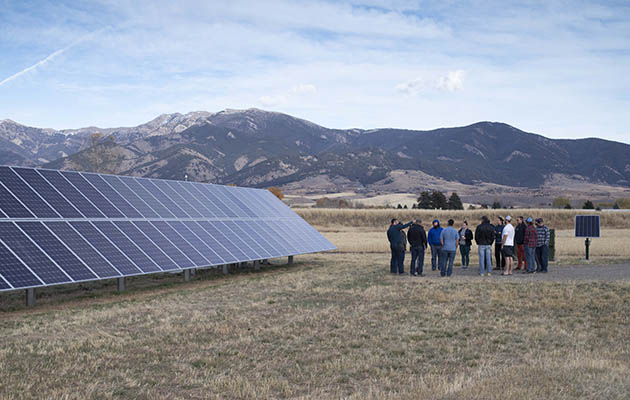
Montana State University and NorthWestern Energy are working together to develop senior design capstone projects associated with these solar pilot projects. The capstone course is required to graduate with an engineering degree. Students work in small groups over two semesters to identify an opportunity, define the problem, analyze competing needs and requirements, develop alternative designs, carry out cost analyses, and select and implement a design solution. Below is a summary of their research projects by site.
MSU Design Projects:
Deer Lodge Microgrid
- Microgrid Optimization (2015-2016) - Students are evaluating possibilities to minimize microgrid costs by analyzing opportunities to reduce inrush current to support loads, optimizing storage to match outage durations, and identifying standby heating/cooling loads for the batteries. Their research will help lead to more affordable microgrid projects.
Bozeman Solar Project
- Solar Acoustical Barriers (2017-2018) - Students are understanding how to use solar photovoltaics as an acoustical sound barrier for use near roads, highways, and airports. Specific research includes identifying the sounds characteristics of a solar panel, developing a model for noise-reducing PV barriers, and analyzing solar production when panels are optimized for acoustical benefit. Their research will help develop alternative solutions for community solar developments and roof mounted arrays when the sites are not situated for optimal solar production.
- Solar Orientation (2016-2017) - Increasing grid penetration of solar photovoltaics can cause the utility’s generation to drop mid-day due to solar production, resulting in a steep ramp-up starting in the late afternoon/evening when the sun starts to set. This steep ramp-up, also known as the duck-curve, causes increased stress on the utility’s generation to meet utility peak load, usually occurring around 6:00 p.m. Students are developing a model to optimize the output and orientation of the PV panels to lessen the impacts to the utility.
- Advanced Inverters (2016-2017) - An Inverter takes low-voltage, high current signal from the PV panels and converts them into AC signals that are directly compatible with the utility grid. This inverter technology has advanced quickly over the last several years. The students are evaluating and testing new inverter controls to help further safety and stability of the utility grid. Their research will help understand how new controls will be integrated into the utility’s system control in the future.


